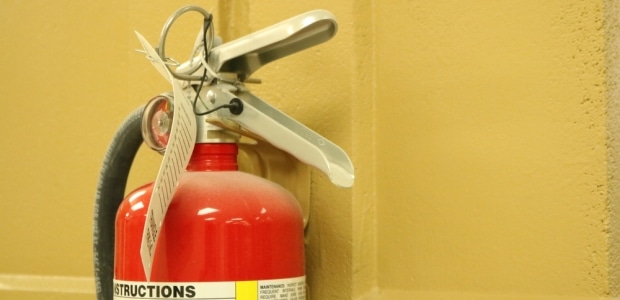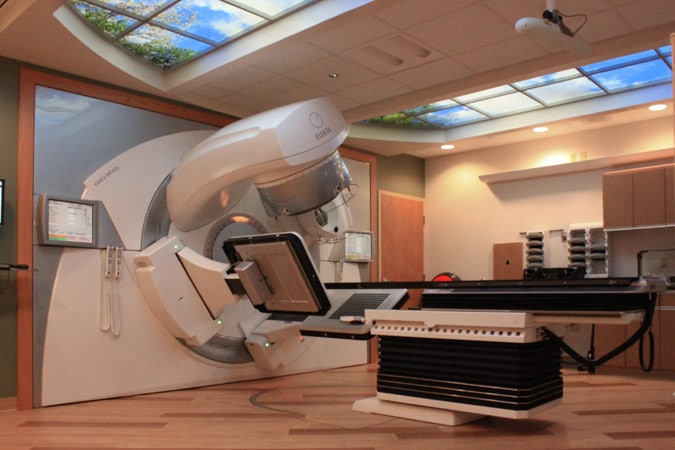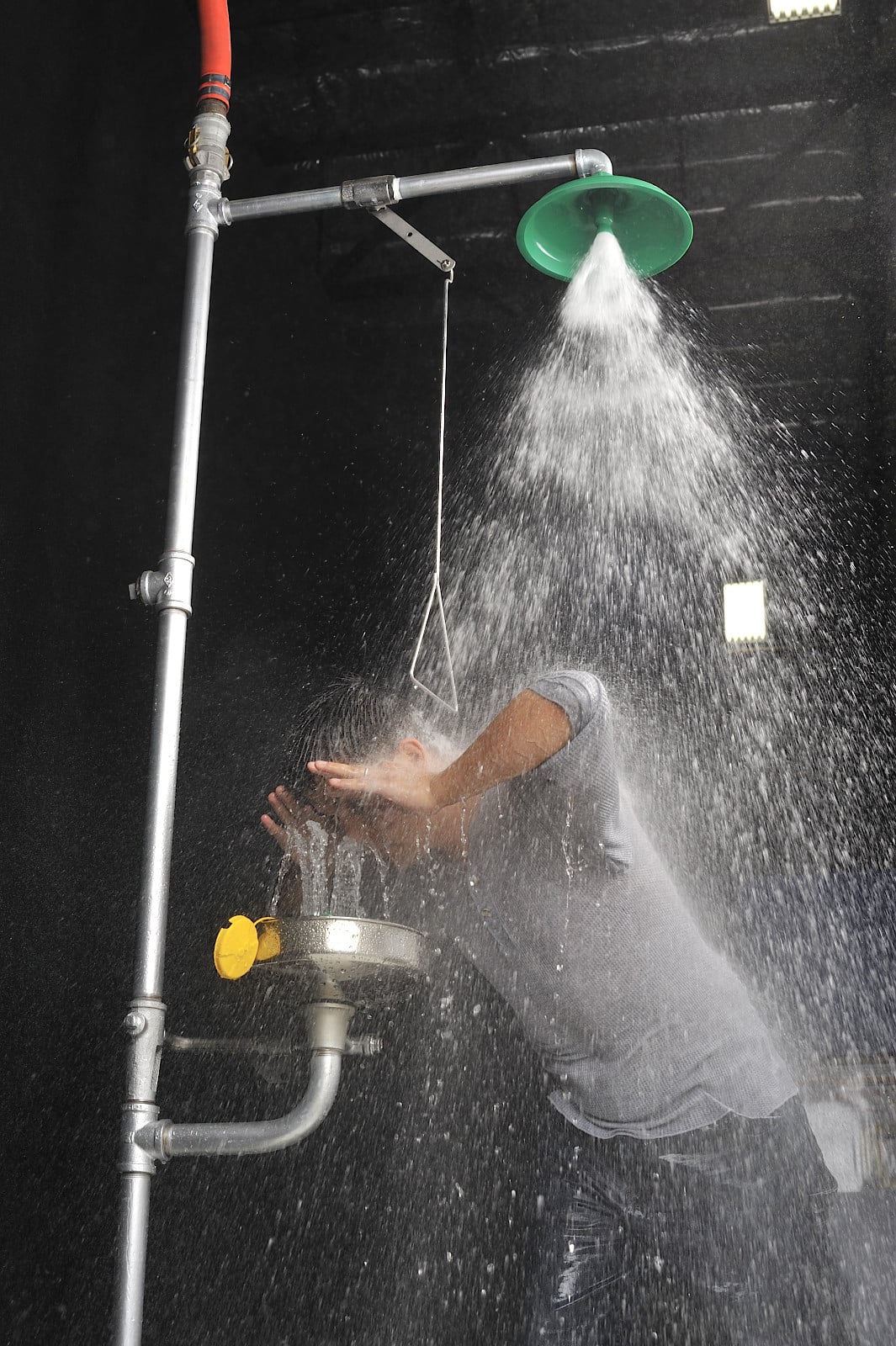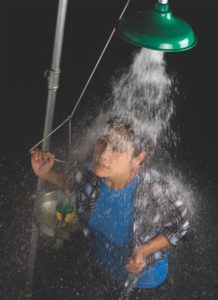[via OHS Online]
 Six Emergency Response Habits Employees Need to Develop
Six Emergency Response Habits Employees Need to Develop
Employees need to refresh their training and have drills regularly so they will be able to rely on both their knowledge and their experience when emergencies happen.
By Karen D. Hamel Jul 01, 2017
If safety glasses, ear plugs, and steel-toed shoes are required in a production area, most employees who work there every day will eventually get into the habit of wearing them—especially when they receive coaching and positive reinforcement for remembering them. When the same start-up procedure is used at the beginning of the shift every day, it will become habitual, too.
Developing good safety habits can help reduce the chance of injuries. But what happens when there is an emergency or something out of the normal happens? Employees need to be just as prepared for the unexpected as they are for routine operations.
Training employees on the types of emergencies that could happen at or around the facility and what their role is during those emergencies are essential first steps in preparing them to respond appropriately. In some cases, the training may be even be required by OSHA regulations. Drills help everyone to apply what they have learned and actually walk through the response process so that it becomes familiar. The trick is having drills often enough that employees can develop emergency response habits.
Many professional responders agree that when there is an emergency, people’s actions don’t rise to the occasion—they fall back to their highest level of training. This happens because it is what they know, which makes them comfortable with the actions they need to take. That’s one of the reasons why even the most seasoned responders train and drill regularly, so that they know what they are going to do, which makes them ready to act instinctively when the need arises.
Given that even professional responders continually train and drill so that they will be prepared to act, it is wrong to assume that employees will instinctively know what to do when there is an emergency. Just like the firefighters, hazmat team, ambulance crew, or anyone else who may be called for assistance, employees need to refresh their training and have drills regularly so that they will be able to rely on both their knowledge and their experience when emergencies happen.
While it is probably not realistic to train every employee to be a contingency planner who is prepared for any time of emergency that could ever happen, each employee needs to specifically know what they are expected to do during different types of emergencies. Here are a few of the basic emergency response habits every employee can develop.
Exit Routes
Some facilities have multiple types of alarms, but for many facilities, an alarm means that something is wrong and everyone should evacuate. Each employee should know where the exit routes are and where the closest exit is. In addition, they should also be able to leave the building at least two different ways.
Be sure that evacuation drills allow employees to practice using both primary and alternative routes so that they are less likely to panic if they aren’t able to use their primary route in an emergency. Employees also should know where to go after they leave the building and whom to report to after they have evacuated.
Chemical Splashes
Under OSHA’s Hazard Communication Standard, hazardous chemical containers need to be properly labeled. The information on the label provides basic information about a chemical’s hazard. But when an employee has been splashed or unsafely exposed to a hazardous chemical, Safety Data Sheets (SDS) can provide more details to better help the affected employee. Knowing where to locate SDS and how to quickly find the one that is needed allows faster response and can lessen the extent of an injury.
Eyewash Stations and Drench Showers
In areas where corrosive chemicals are used, knowing how to get to eyewash stations and drench showers quickly can literally mean the difference between a first aid incident and a recordable injury with a long recovery time. Try blindfolding employees to see whether they can reach the nearest eyewash or drench shower in less than 10 seconds.
Fire Extinguishers
Most building codes require fire extinguishers; because they need to be checked monthly, most are fully charged and ready to use. However, whether or not employees should actually use them is sometimes a debate. Some facilities develop “do not use” policies because they feel that having an employee attempt to put out an incipient fire with an extinguisher is too big of a risk. Instead, they want their employees to pull the fire alarm and exit the building.
For facilities that do not have this type of policy, annual fire extinguisher drills can help them to remember to pull, aim, squeeze, and sweep. Be sure that these drills also include instruction on exiting the building if they have exhausted an extinguisher but have failed to put out the fire.
Spill Response
Most spills that happen in fixed facilities are small and can be safely cleaned up by employees in the immediate area. OSHA calls these “incidental spills.” When a spill creates an unsafe atmosphere or threatens the health of employees, it is most likely an “emergency spill” and needs to be cleaned up by employees who have been trained to OSHA’s Hazardous Waste Operations and Emergency Response (HAZWOPER) Standard.
All employees need to be taught how to quickly determine whether they are capable of cleaning up a spill or need to call in trained emergency spill responders. Volume, location, chemical properties, and levels of training are all factors that need to be taken into consideration when training employees how to determine whether a spill is incidental.
Injury Response and Reporting
Facilities that are not located in close proximity to hospitals or infirmaries need to have employees who are trained to administer first aid. While it is not necessary for every employee to receive first aid training, it is important for every employee to know what to do when someone is injured. At a minimum, every employee should know whom to report an injury to, as well as the process that will be used to investigate the root cause of an incident. Even elementary skills such as being able to retrieve the first aid kit or AED, or being able to meet the ambulance at the door and direct them to an injured employee, are helpful.
Few people ever reach the point where responding to emergencies is as instinctive as tying their shoes. But without regular emergency training and drills, response actions will never become familiar, let alone become habits. The more comfortable employees are with their roles in emergency response, the more likely they will be to follow established plans and avoid injuries.
This article originally appeared in the July 2017 issue of Occupational Health & Safety.
Trends in Emergency Eyewashes and Showers
Quick access to an emergency eyewash/shower station is vital in the event of an incident. “The first 10 to 15 seconds after exposure to a hazardous substance, especially a corrosive substance, are critical,” the Canadian Center for Occupational Health and Safety states. CCOHS goes on to note that delaying treatment, even for just a few seconds, may result in serious injury to a worker. Below, industry insiders discuss common mistakes regarding emergency eyewashes/showers, and what’s new in the field.
How mistakes happen
Water temperature issues and lack of testing are common mistakes that occur with emergency eyewashes/showers. If the water is too cold – or too hot – the user is much less likely to withstand the full 15-minute flush.
Casey Hayes, director of integrated sales and operations for Sparks, NV-based Haws Corp., also spoke of issues with not flushing for the full 15-minute period. “This is attributed to either product deficiency or improper training,” Hayes said. “Weekly and yearly testing will mitigate against product issues, but it’s important to frequently train and re-train team members.”
Advancements
Comfort is, not surprisingly, a driving force when it comes to product advancements. “Eyewash and safety showers are transitioning to focus on victim comfort and ease of use as the primary features,” Hayes said. “This includes smooth water flows for comfortable water pressure, internal flow control to match ANSI Z358.1 flow and velocity requirements, and a reasonable water temperature to encourage a full 15-minute flush.”
So what’s the most important thing workers should know concerning emergency eyewashes and showers? According to Hayes, it’s the ability for workers to know how to operate emergency equipment. “If a victim cannot properly use the equipment for the required time there is a potential for increase of injury and associated liabilities,” he said.
Case Study: Hospital Safety Upgrades Match Commitment to Health EnhancementFor more than a century, Monongahela Valley Hospital (MVH) has served Pennsylvania’s mid-Monongahela Valley with an emphasis on quality care and compassionate caring. The 226-bed, full-service health care facility maintains a staff of more than 1,000, making it the largest employer in the valley. The hospital remains steadfast in its commitment to meeting the needs of not only its employees, but also the thousands of patients that visit annually.  As part of a large renovation at MVH, one of the hospital’s laboratories relocated to a new facility. The project’s architects took full advantage of this opportunity to upgrade the lab’s safety equipment to ensure the safety of the hospital staff. They wanted reliable products that worked on several levels – efficiency, innovation, compact size and ease of use – while also meeting stringent OSHA and ANSI standards.
As part of a large renovation at MVH, one of the hospital’s laboratories relocated to a new facility. The project’s architects took full advantage of this opportunity to upgrade the lab’s safety equipment to ensure the safety of the hospital staff. They wanted reliable products that worked on several levels – efficiency, innovation, compact size and ease of use – while also meeting stringent OSHA and ANSI standards.
After evaluating the scope of emergency products on the market, both the Haws® AXION® MSR eye/face wash and AXION MSR combination eye/face wash and shower proved ideal. As leading safety products, they fell perfectly in line with the hospital’s commitment to quality and staff/patient satisfaction. A revolutionary inverted flow design makes the AXION MSR eye/face wash the only product on the market consistent with EMT and emergency room protocols, while the combination eye/face wash and shower offers a hydrodynamic design with regulated water flow that ensures maximum effectiveness in an emergency situation. Integral flow controls and easy activation are additional standout features.
In selecting the Haws products, MVH offers a response that concentrates on victim comfort while exceeding the ANSI Z358.1 standard requirements. “The units work well,” and staff has found them “easy to start, especially… in a hurry,” says MVH Laboratory Supervisor, Betty Ritzer. The eye/face wash has been used once, with very positive feedback, and Ritzer’s weekly maintenance checks have her sold on the safety equipment’s quality. AXION’s ground-breaking technology continues to change the emergency response landscape by offering the only eye/face wash duplicating the methodology recommended and used by medical professionals. The AXION MSR eye/face wash and shower provide superior safety technology for use in labs, schools and healthcare offices and are available in a variety of configurations and install options. All AXION MSR products are certified by CSA to meet ANSI Z358.1.
To download or print the case study, click here.
Safety Tip: The Importance of Tempered Water for Victim ComfortIn the morning before hopping into the shower, you may overestimate how low your body temperature is and turn the shower dial to the hottest that it will reach. You then step your entire body into the water and react to the scalding hot water by stepping away from the water, and turning the dial to a lower temperature. Unfortunately in an emergency situation, you are not given the chance to adjust the temperature of flowing water. Emergency eyewashes and emergency showers can be the solution to mitigating an injury while on the job. But if the equipment produces water that is either too hot or too cold and does not comply with ANSI Z358.1, the injury could possibly be made worse.  Water temperature should range from 60° to 100° F (15.5° C to 37.7° C) throughout the entire 15 minute drench or irrigation cycle. When showering at your home shower, the temperature should rest around 105° F (40.5° C). Room temperatures range around 68° F to 70° F (20 °C to 21.1°C), so it is important to consider victim comfort when running water temperature in an emergency shower or eyewash. If the temperature should fall around the lower range of the ANSI requirement, the victim may not feel comfortable through the duration of the cycle. A thermostatic mixing valve that regulates temperature spikes is fitting in making sure temperature stays controlled.
Water temperature should range from 60° to 100° F (15.5° C to 37.7° C) throughout the entire 15 minute drench or irrigation cycle. When showering at your home shower, the temperature should rest around 105° F (40.5° C). Room temperatures range around 68° F to 70° F (20 °C to 21.1°C), so it is important to consider victim comfort when running water temperature in an emergency shower or eyewash. If the temperature should fall around the lower range of the ANSI requirement, the victim may not feel comfortable through the duration of the cycle. A thermostatic mixing valve that regulates temperature spikes is fitting in making sure temperature stays controlled.  The victim is the number one priority in emergency situations, and you want the victim to abide by flush requirements in order to alleviate the injury. If the temperature is uncomfortable to the victim, the victim will feel pressure to leave the shower which may exacerbate the injury. We want the victim to feel comfortable, and once the victim does find comfort, he or she is more likely to remove contaminated clothing to boost the wash objective. Tempered water is a crucial factor to consider for victim comfort. Avoid legal repercussions and test your emergency shower and eyewash’s temperature regularly! Read more about ANSI Z358.1 requirements here.
The victim is the number one priority in emergency situations, and you want the victim to abide by flush requirements in order to alleviate the injury. If the temperature is uncomfortable to the victim, the victim will feel pressure to leave the shower which may exacerbate the injury. We want the victim to feel comfortable, and once the victim does find comfort, he or she is more likely to remove contaminated clothing to boost the wash objective. Tempered water is a crucial factor to consider for victim comfort. Avoid legal repercussions and test your emergency shower and eyewash’s temperature regularly! Read more about ANSI Z358.1 requirements here.




